Slate Vesper (talk | contribs) mNo edit summary |
|||
| (46 intermediate revisions by 21 users not shown) | |||
| Line 1: | Line 1: | ||
| − | {{Era| |
+ | {{Era|Locations|Assassins}} |
| − | {{ |
+ | {{Revamp}} |
| + | [[File:NVS 22.png|thumb|250px|Darius' sarcophagus inside Santa Maria Novella]] |
||
| ⚫ | |||
| + | The '''Assassin Tombs''' were six hidden tombs or shrines dedicated to several notable proto-Assassins and located across [[Italy]] between at least 1290 and 1486. |
||
| − | {{Location infobox |
||
| − | |name = Assassin's Tombs |
||
| − | |image =Tombentrance.png |
||
| − | |imgdesc = |
||
| − | |hidep = No |
||
| − | |state = Various |
||
| − | |rulers = Various |
||
| − | |factions = [[Assassins]] |
||
| − | |hideh = |
||
| − | |founded = |
||
| − | |date = |
||
| − | |abandoned = |
||
| − | |hidea = |
||
| − | |landmark = |
||
| − | |flags = |
||
| − | |targets = |
||
| − | |}} |
||
| ⚫ | Built by members of the [[Italian Brotherhood of Assassins]] as dedications to the lives of their residents, each crypt contained a wealth of treasure, and a statue of the Assassin who was being dedicated. Furthrmore, inside each tomb lay an [[Assassin Seals|Assassin Seal]], which, when brought together with the other five, unlocked a secure gate in the [[Sanctuary]], beneath the [[Villa Auditore]]. Beyond the gate, the legendary [[Armor of Altaïr]] could be accessed. |
||
| − | The '''Assassin Tombs''' were six tombs hidden across northern [[Italia|Italy]] between 1290 and 1476 C.E. by members of the [[Assassins|Assassin's Order]]. The tombs, created as dedications to the lives of their residents, held the bodies of six legendary Assassins that had been exhumed and moved from their previous burial sites. |
||
| ⚫ | |||
| ⚫ | |||
| ⚫ | |||
| − | == |
+ | ===Florence and San Gimignano=== |
| ⚫ | |||
| ⚫ | |||
| ⚫ | There were three tombs within the regions of [[Florence]] and [[Tuscany]]. The first was located within the catacombs of the [[Basilica di Santa Maria Novella|Santa Maria Novella]], and was discovered by the Assassin [[Ezio Auditore da Firenze]] in 1478, after eavesdropping on a Templar meeting. This tomb was the resting place of [[Darius]], who assassinated [[Xerxes I of Persia]]. |
||
| ⚫ | |||
| − | ===Firenze and San Gimignano=== |
||
| ⚫ | There were three tombs within the |
||
| ⚫ | The third tomb was within San Gimignano, and was built atop the [[Torre Grossa]], although entrance to the tomb was only possible by passing through the city's [[Palazzo Comunale, San Gimignano|Palazzo Comunale]] below. This tomb was the resting place of [[Wei Yu]], who had assassinated the first Emperor of China, [[Qin Shi Huang]]. |
||
| ⚫ | |||
| ⚫ | |||
| ⚫ | |||
| ⚫ | |||
| + | [[File:See You There 2.png|thumb|250px|The secret entrance's mechanism in use]] |
||
| − | |||
| ⚫ | |||
Within the territories of [[Romagna]] and the Venetian lagoon, three more tombs were built. In Forlì, beneath the [[Rocca di Ravaldino]], lay the tomb of [[Qulan Gal]], the deathbringer of [[Genghis Khan]]. |
Within the territories of [[Romagna]] and the Venetian lagoon, three more tombs were built. In Forlì, beneath the [[Rocca di Ravaldino]], lay the tomb of [[Qulan Gal]], the deathbringer of [[Genghis Khan]]. |
||
| − | The other two lay in Venice; within the [[San Marco District (Venice)|district of San Marco]], |
+ | The other two lay in Venice; within the [[San Marco District (Venice)|district of San Marco]], the eponymous [[St. Mark's Basilica|Basilica di San Marco]] housed a cenotaph of [[Amunet]], who had been responsible for the death of [[Cleopatra]] and whose remains actually rested in [[Egypt]].<ref name="ACO">''[[Assassin's Creed: Origins]]''</ref> |
| + | |||
| + | The final tomb was beneath the [[Santa Maria della Visitazione]], which held the body of [[Leonius]], killer of [[Caligula]]. |
||
===Monteriggioni=== |
===Monteriggioni=== |
||
| + | [[File:Paying_Respects_6.png|thumb|250px|left|Ezio in the Auditore family crypt]] |
||
| − | Built in [[Monteriggioni]] during the late |
+ | Built in [[Monteriggioni]] during the late 13th century, the [[Auditore Family Crypt]] was constructed by [[Domenico Auditore]] to serve as the resting place of Domenico and his son. The story of Domenico's life was inscribed across the walls along the pathway, from the main entrance to the crypt itself. |
| + | |||
| + | During the 15th century, Domenico's great-great-grandson Ezio Auditore explored the crypt and learned of his family's history and its involvement with the Assassins. |
||
==Armor of Altaïr== |
==Armor of Altaïr== |
||
| ⚫ | |||
{{Main|Armor of Altaïr}} |
{{Main|Armor of Altaïr}} |
||
| ⚫ | |||
| − | Obtaining all Assassin's Seals unlocked Altaïr's armor, a suit of armor with the highest defense obtainable. Altaïr created the armor using the [[Apple of Eden|Apple of Eden |
+ | Obtaining all Assassin's Seals and placing them in their respective statues unlocked the gate which locked away Altaïr's armor, a suit of armor with the highest defense obtainable. Altaïr created the armor using the knowledge he absorbed through studying the [[Apple of Eden 2|Apple of Eden]], to make it invulnerable to many weapons and dangers. It was indestructibe and unlike other types of armor it required no repairs. Dyes purchasable from tailors were not visible upon the armor, save on the inside of the hood. |
| − | |||
| ⚫ | |||
| ⚫ | |||
| − | ==See also== |
||
| ⚫ | |||
| − | == |
+ | ==Appearances== |
| − | * |
+ | *''[[Assassin's Creed II]]'' |
| + | ==References== |
||
| − | {{ACII}} |
||
| + | {{Reflist}} |
||
| − | [[Category:Assassin's Creed II Locations]] |
||
| ⚫ | |||
| − | [[Category:Assassin's Creed II Secret Locations]] |
||
| − | [[Category:Assassin |
+ | [[Category:Assassin Brotherhood]] |
| − | [[Category: |
+ | [[Category:Shrines]] |
Revision as of 12:13, 7 June 2019

|
Ezio, my friend! How may I be of service? This article is in desperate need of a revamp. Please improve it in any way necessary in order for it to achieve a higher standard of quality in accordance with our Manual of Style. |
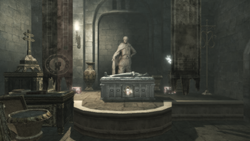
Darius' sarcophagus inside Santa Maria Novella
The Assassin Tombs were six hidden tombs or shrines dedicated to several notable proto-Assassins and located across Italy between at least 1290 and 1486.
Built by members of the Italian Brotherhood of Assassins as dedications to the lives of their residents, each crypt contained a wealth of treasure, and a statue of the Assassin who was being dedicated. Furthrmore, inside each tomb lay an Assassin Seal, which, when brought together with the other five, unlocked a secure gate in the Sanctuary, beneath the Villa Auditore. Beyond the gate, the legendary Armor of Altaïr could be accessed.
Locations
The tombs were hidden within various churches and landmarks across a number of towns and cities in Italy, namely Florence, Venice, San Gimignano and Forlì. Secret paths to these tombs are opened by unlocking skull-shaped locks.
Florence and San Gimignano
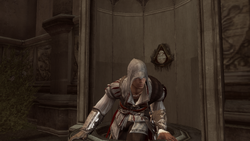
Ezio entering the Santa Maria Novella tomb
There were three tombs within the regions of Florence and Tuscany. The first was located within the catacombs of the Santa Maria Novella, and was discovered by the Assassin Ezio Auditore da Firenze in 1478, after eavesdropping on a Templar meeting. This tomb was the resting place of Darius, who assassinated Xerxes I of Persia.
The second tomb was located in the Santa Maria del Fiore, within the lanterna above the building's domed top. Here rested Iltani, who was responsible for the death of Alexander the Great.
The third tomb was within San Gimignano, and was built atop the Torre Grossa, although entrance to the tomb was only possible by passing through the city's Palazzo Comunale below. This tomb was the resting place of Wei Yu, who had assassinated the first Emperor of China, Qin Shi Huang.
Forlì and Venice
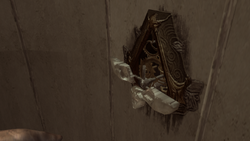
The secret entrance's mechanism in use
Within the territories of Romagna and the Venetian lagoon, three more tombs were built. In Forlì, beneath the Rocca di Ravaldino, lay the tomb of Qulan Gal, the deathbringer of Genghis Khan.
The other two lay in Venice; within the district of San Marco, the eponymous Basilica di San Marco housed a cenotaph of Amunet, who had been responsible for the death of Cleopatra and whose remains actually rested in Egypt.[1]
The final tomb was beneath the Santa Maria della Visitazione, which held the body of Leonius, killer of Caligula.
Monteriggioni
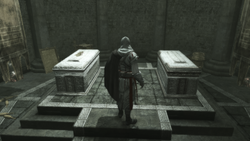
Ezio in the Auditore family crypt
Built in Monteriggioni during the late 13th century, the Auditore Family Crypt was constructed by Domenico Auditore to serve as the resting place of Domenico and his son. The story of Domenico's life was inscribed across the walls along the pathway, from the main entrance to the crypt itself.
During the 15th century, Domenico's great-great-grandson Ezio Auditore explored the crypt and learned of his family's history and its involvement with the Assassins.
Armor of Altaïr
- Main article: Armor of Altaïr
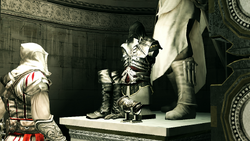
Ezio obtaining the Armor of Altaïr
Obtaining all Assassin's Seals and placing them in their respective statues unlocked the gate which locked away Altaïr's armor, a suit of armor with the highest defense obtainable. Altaïr created the armor using the knowledge he absorbed through studying the Apple of Eden, to make it invulnerable to many weapons and dangers. It was indestructibe and unlike other types of armor it required no repairs. Dyes purchasable from tailors were not visible upon the armor, save on the inside of the hood.
This armor was later buried in the rubble of Villa Auditore during the Siege of Monteriggioni, when Cesare Borgia launched an attack on the town to recover the Apple of Eden from the Assassins.
Appearances
References
